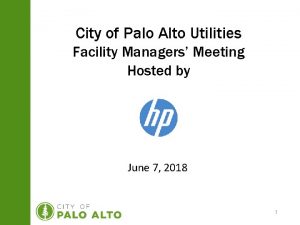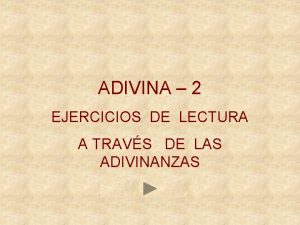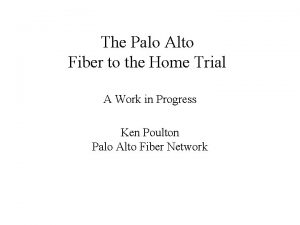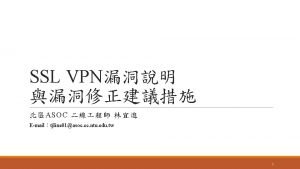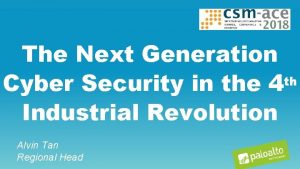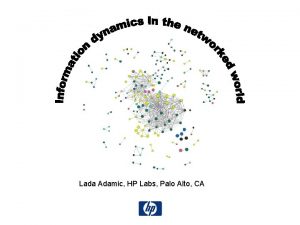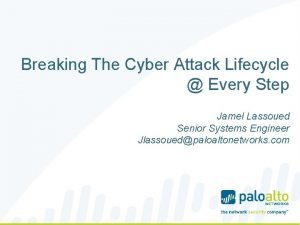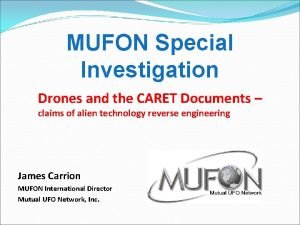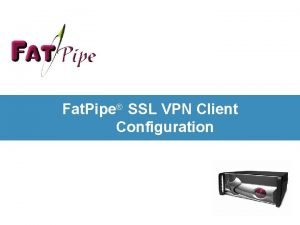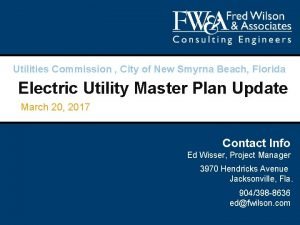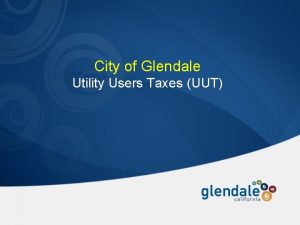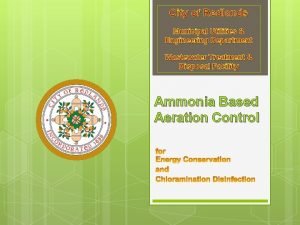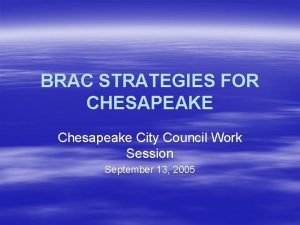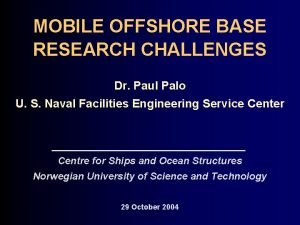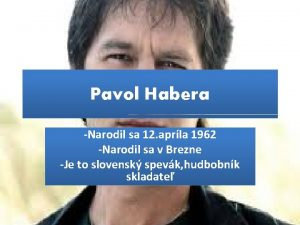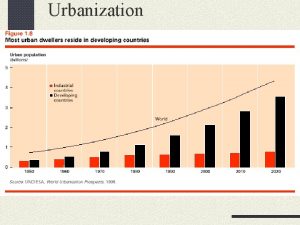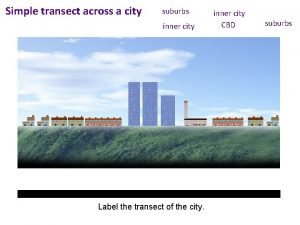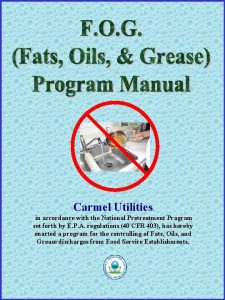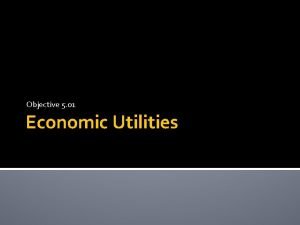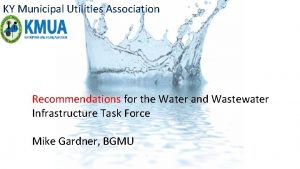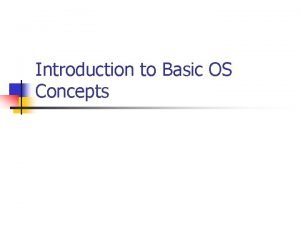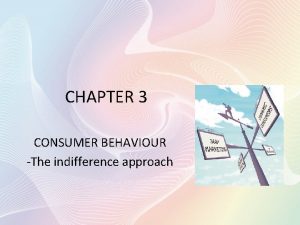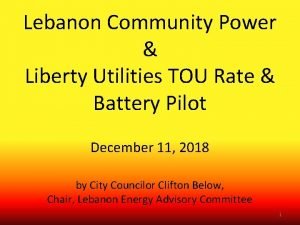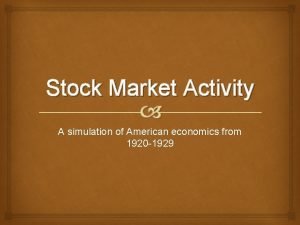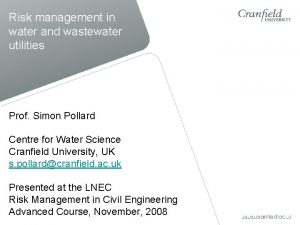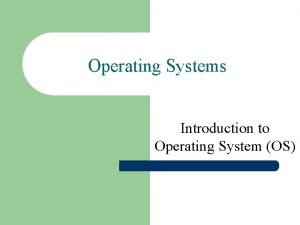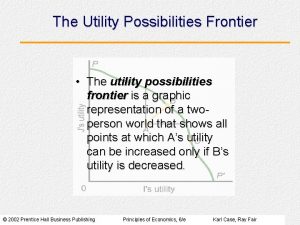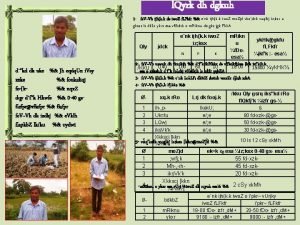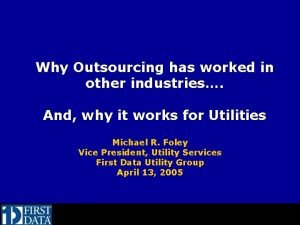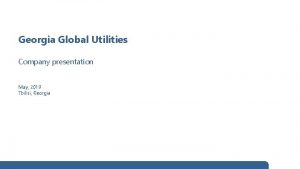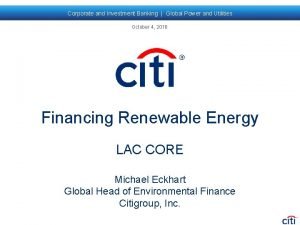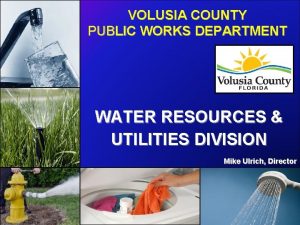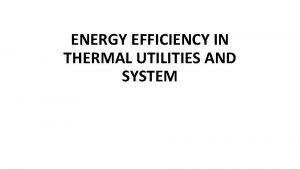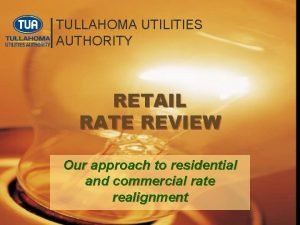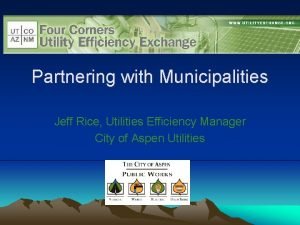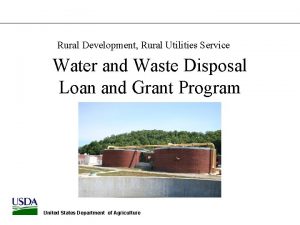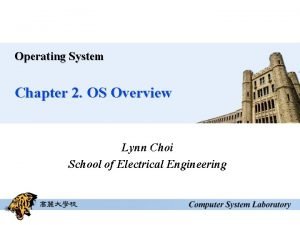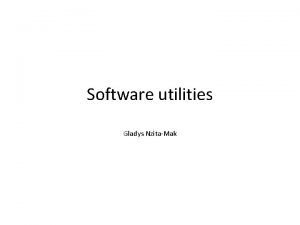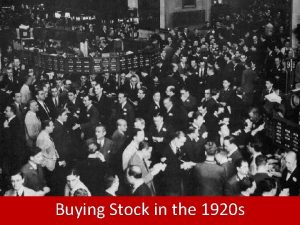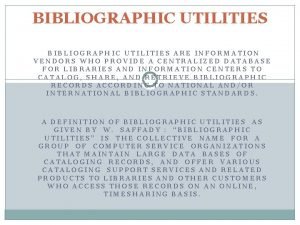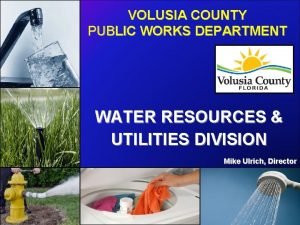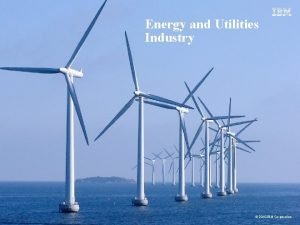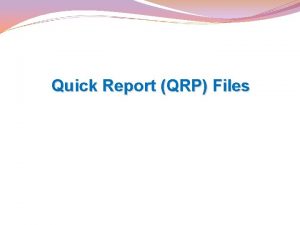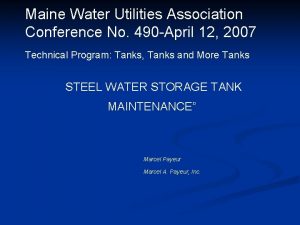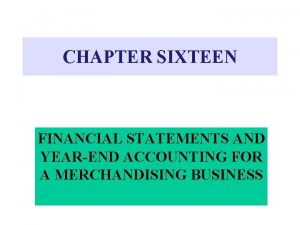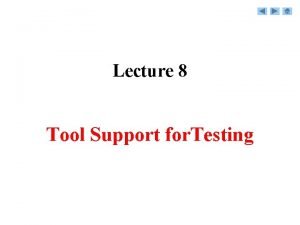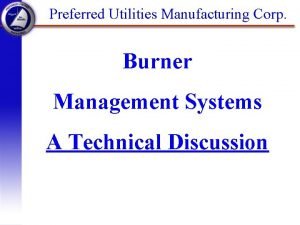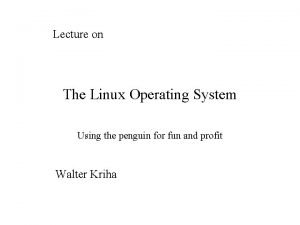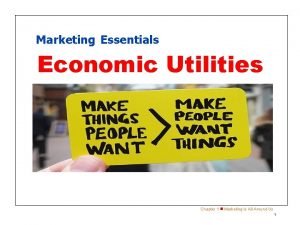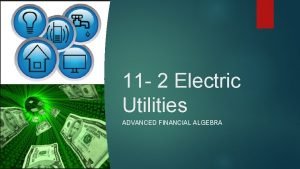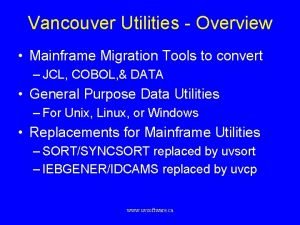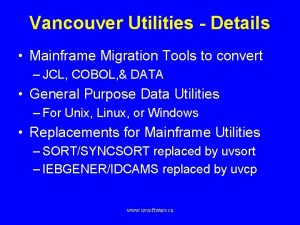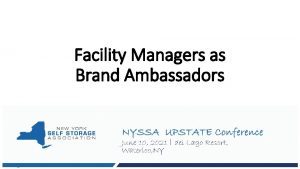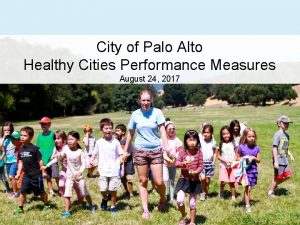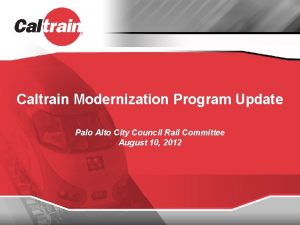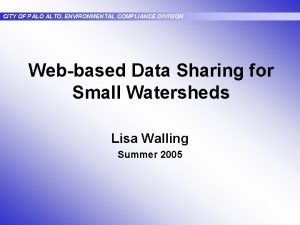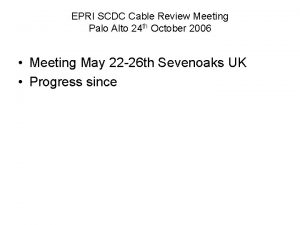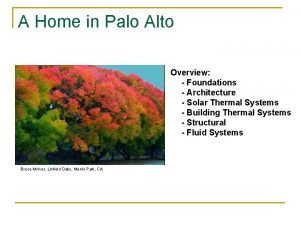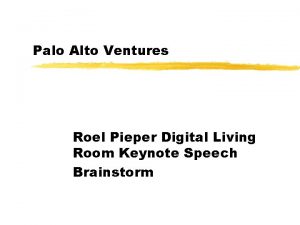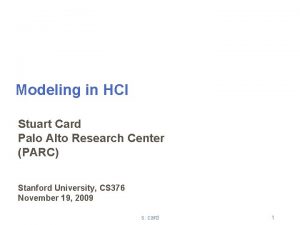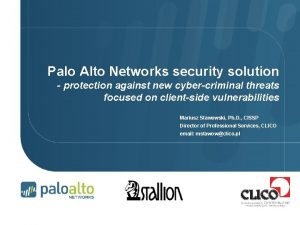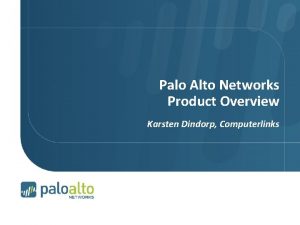City of Palo Alto Utilities Facility Managers Meeting

























































































- Slides: 89

City of Palo Alto Utilities Facility Managers’ Meeting Hosted by June 7, 2018 1

Agenda: VA Palo Alto HCS rebate presentation AB 802 and Demand Response Enovity: Commercial and industrial Energy Efficiency TRC Solutions: ASHRAE Guideline 36 CPAU: Proposed Rate Changes HP: Reinventing Energy and Sustainability Management 2

California Energy Commission Building Energy Benchmarking Program AB 802 6 -7 -2018 3

California Assembly Bill 802 (2015) The State of California passed Assembly Bill 802 in October 2015 to provide data access and to create a benchmarking and public disclosure program. § Data access–establishes standards under which utilities must provide whole-building energy use data upon request by a building owner or their representative for 13 months and within 14 days of the request. § Benchmarking, reporting, and public disclosure–defines requirements for owners of buildings of certain sizes and uses to benchmark their properties and report the results to the California Energy Commission 4

Definitions Covered Building § A building for which a utility is required to provide energy use data upon request. § Commercial utility accounts or § Five or more active utility accounts, at least one of which is residential Disclosable Building (Mandatory) § A covered building for which annual reporting to the Energy Commission is required and has to be more than 50, 000 square feet of Gross Floor Area and has either § No active residential utility accounts or § 17 or more active residential utility accounts of each energy type serving the building 5

6

Building Exemptions Some reporting exemptions examples: § The building did not have certificate of occupancy during the 12 -month reporting period § The building is scheduled to be demolished within one year of the reporting date § The building is covered by approved local building energy-use benchmarking program (SF) § The building has more than half of the gross floor area used for scientific experiments requiring a controlled environment or industrial purposes 7

Important dates Building Energy Benchmarking Program – Request utility data by April 2018, and by each March 1 thereafter. – Bldg. Owner submits data to CEC by June 1, 2018, and by each June 1 thereafter. – Submit Portfolio Manager data to CEC by June 1, 2018, and by each June 1 thereafter. • CEC understands that the time line was short and will not fine anyone at this time but strongly suggest that you get the data in as soon as you can. 8

Energy Star Portfolio Manager ENERGY STAR Portfolio Manager § Provided by the U. S. Environmental Protection Agency (EPA) § Secure, free, and interactive online energy management tool § Helps track and assess energy, water, and waste consumption https: //www. energystar. gov/buildings/facility-owners-andmanagers/existing-buildings/use-portfolio-manager OPTIONAL § There are CPAU consultants who can assist you with benchmarking 9

Frequently Asked Questions (FAQs) § The California Energy Commission's website will host a list of FAQs regarding the AB 802 policy, the Energy Benchmarking and Disclosure Program, guidance on how to comply, an § http: //www. energy. ca. gov/benchmarking/ 10

CPAU is here to help § Talk to your Account Rep to find out if your buildings must comply. § Brian Ward brian. ward@cityofpaloalto. org § Vic Farisato victor. farisato@cityofpaloalto. org § Josh Wallace josh. wallace@cityofpaloalto. org § UTL-Data Request UTL-Data. Request@Cityof. Palo. Alto. org 11

Want to earn rewards by being smarter about when you use electricity? Demand Response Program 2018 How the Program Works Eligibility Requirements • Earn 50₵/k. Wh for energy reduction during DR events • Receive advanced metering equipment • Portal to view your 15 -minute electricity usage online • Commercial electric customer in good standing • Commit to at least 50 k. W of energy reduction • No backup generation to reduce metered load during a DR event ü Reduce electricity from 26 pm ü Earn rewards and help the grid stay green Click Here to Download Flyer & Application (on Facility Manager Meeting Webpage) 12

Commercial Industrial Energy Efficiency Program Customized Facility Services and Support for CPAU Customers since 2009 Prepared for: Prepared by: CPAU and Key Account Facility Managers Jeff Guild, PE Director June 7, 2018

We are Enovity Higher Performance Places We are engineers who operate, maintain, and optimize facilities to create sustainable environments where people and organizations prosper. Energy Efficiency, Commissioning, Facilities Engineering, Smart Buildings WATER WASTE ENERGY 100 40 1. 1 million people supplied with drinking water Company Overview million people provided with collection services billion square feet of commercial buildings served with energy

Commercial & Industry Energy Efficiency Program How It Works Assess Potential Investigate Projects Approve Incentive Install Project Verify Performance Pay Incentive Results 2009–Present (Annualized) Company Overview 35 325, 000 $3. 5 million k. Wh of electricity saved therms of natural gas saved million in costs saved

Pharmaceutical Research Lab Client: (55 k. SF) CPAU Key Account Services: CIEEP Program Technical Assistance and Cash Incentives Air Handler Replacement + DDC Controls Replaced Pneumatic Controls Improved airflow control to spaces and added after- hours setbacks at non-critical areas, Demand-based Supply air temperature reset to reduce simultaneous heating & cooling (gas and electric) Results: $60 k (15%) annual cost reduction Case Studies – Pharma Lab

Office & Data Center (62 k. SF) Client: CPAU Key Account Services: CIEEP Program Technical Assistance and Cash Incentives Equipment Replacement + DDC Controls Replace Air Handlers & Cooling tower Pneumatic to DDC upgrade to serve all mechanical systems (Air Handlers, Chillers, Boilers Terminal Boxes) Comprehensive advanced control strategies implemented for resets and after-hours scheduling & setbacks Results: $83 k (22%) annual cost reduction Case Studies – Pharma Lab

Medical Technology (185 k. SF) Client: CPAU Key Account Services: CIEEP Program Technical Assistance, Turnkey Implementation, and Cash Incentives Turnkey Retrocommissioning Implement comprehensive advanced control strategies – Demand-based static pressure and temperature resets and dual max VAV – Scheduling and Optimum Start – Economizer Sequencing Improve system operations – VAV Temperature and Flow sensor calibration – Building pressurization stabilization Results: $86 k (23%) annual cost reduction Case Studies – Pharma Lab


ASHRAE Guideline 36: Best-in-Class Sequences of Operation Palo Alto Facility Managers’ Meeting Farhad Farahmand, PE Rupam Singla, PE TRC Energy Services 6/7/2018 20

Overview Agenda What is ASHRAE Guideline 36 (G 36)? What is the Value of G 36? What is the EPIC Best-in-Class Research Project? Discussion and feedback • TRC Energy Services – Emerging tech research, policy analysis, codes and standards development, incentive program design and implementation, … – Clients are mostly government and utilities 21

Who likes HVAC Controls? • Each building is a unique effort, requiring a mix of custom design and copy/paste • Competing pressures for installers • Prone to human error and inconsistent performance • Controls sequences opaque to many designers / operators $$ 22

Solution: ASHRAE Guideline 36 • Standardized set of optimized control sequences – Currently for Variable-Air. Volume (VAV) systems – Wet-side systems (e. g. , central plants) under research • Refined through years of research and implementation • Broad industry support • 1 -month from being published 23

Guideline 36 Improves Performance • • ASHRAE experts create and maintain advanced sequences Whole building energy savings – Retrofits and Controls-based Cx 5 -30% 2, 3 – San Mateo County office building Whole building 15% electric savings, 56% gas savings. 1 Payback of 7 years for a full hardware upgrade. • Comfort improvements from reducing over-cooling – 50% reduction in uncomfortable people 4 • Compliant – Energy: ASHRAE Standard 90. 1 and Title 24 – Ventilation: ASHRAE Standard 62. 1 and Title 24 • Reliability – Automated Fault Detection and Diagnostics – Hierarchical alarms: If upstream equipment fails (e. g. AHU) the alarms for downstream equipment (e. g. VAV boxes) suppressed 1 – Taylor Engineering, 555 County Center, San Mateo, CA 2 – Roth, K, Llana, P, Westphalen, D, Broderick, J. 2005. Automated Whole Building Diagnostics. ASHRAE Journal 47(5): 82 -84. 3 - Katipamula, S, Brambley, M. 2005. Methods For Fault Detection, Diagnostics & Prognostics For Building Systems- A Review, Part 1. HVAC&R Research 11(1): 3 -25. 24 4 – ASHRAE Research Project RP-1515: https: //www. cbe. berkeley. edu/research/lowflow. htm

The Details: Energy Savings • Trim and Respond – TRIM: Continuously resets setpoints to save more energy (e. g. , static pressure, supply air temperature) – RESPOND: Based on zone demand, resets setpoints – Optimal for controlling variables subject to req’s of multiple downstream zones • Rogue Zones – Always want MORE (e. g. , static pressure, colder supply air) – Drive the reset loop to extremes and prevents energy savings • Importance Multiplier 25

Trim and Respond respond trim 2 IGNORES 26

The Details: Fault Detection and Diagnostics • Based on NIST research • Only for air handler • Time delays to suppress false alarms 27

Why a Research Project? • Funded by California Energy Commission using Electric Program Investment Charge (EPIC) – Team: Taylor Engineering, Integral Group, Lawrence Berkeley Natn’l Lab, TRC Energy Services • Four year project to develop new industry standard for controls upgrades 28

Research Project Elements • Technology Validation and Optimization – Supporting six manufacturers in preprogramming – Developing a functional performance test • Field Demonstrations at 6 sites – Software upgrade sites (already DDC-tozone) – Hardware + software (pneumatic zones) • Market acceleration – Best practices guides – Cost effectiveness calculations – Incentive program measure recommendations – Codes enhancements

The Grand Vision • Manufacturers preprogram, test, and debug sequences for dealers • Then 30

Guideline 36 Early Adopters • CCCCD, Genentech, CSU-SB, City of Seattle • Are you interested? – Do you have VAV-RH systems? – Pneumatic system? • Requires full hardware upgrade – DDC to the zone? • Software-only upgrade • May require controller upgrade to increase memory for older systems – Please reach out to us for more information 31

Questions? Farhad Farahmand ffarahmand@trcsolutions. com

Can we ask you all some questions? • We are gathering info on: – – How found out about G 36 How G 36 was specified Challenges/lessons learned Successes • How to Answer Polls – POLLEV. COM/TRCUSER. Write username or “skip” to remain anonymous – Text “PEC” to 22 -333. You should receive a confirmation text response. 33


35




APPENDIX SLIDES

Dual Maximum VAV Box Logic per Title 24 and Standard 90. 1 for DDC

Demand Response Ready • Demand limits can be triggered by: initiating utility demand shed events; exceeding a predefined threshold; to prevent excessive rates in a ratchet schedule; etc. • Define Demand Limit Levels to increase/decrease zone group setpoints in a DR event – Cooling Demand Limit Setpoint Adjustment: • At Demand Limit Level 1, increase setpoint by 1 ⁰F • At Demand Limit Level 2, increase setpoint by 2 ⁰F • At Demand Limit Level 3, increase setpoint by 4 ⁰F • Local setpoint adjustments are frozen/ignored in a DR event • Operator ability to exempt individual zones from DR 41

Trim & Respond Setpoint Reset • Used to reset setpoints based on zone demand, e. g. – Static pressure – Supply air temperature – HW and CHW supply temperature • Zones issue “requests” based on zone temperature loops or damper/valve position – E. g. “Generate 1 request when damper position exceeds 95%” – Extra requests can also be generated based on error from setpoint • Multiply “requests” by zone Importance Multiplier – IM=0 means ignore the zone – IM=1 default – IM>1 for critical zones to get past “Ignores” • Send to AHU controller to adjust setpoint – Every time-cycle setpoint is reduced (“trim”) – But setpoint is increased (“respond”) proportional to number of zone “requests” (up to a maximum change)

Trim and Respond Parameters

Rogue Zones • A rogue zone is one that is always requesting more (more static pressure, colder CHW, or hotter HHW) – Example causes • Load larger than anticipated in design • Poor duct design/construction • Extreme setpoint adjustments • Equipment failure (broken damper, valve) • This drives the reset loop to extremes and prevents energy savings. • Once identified (discussed later), rogue zones can be – Repaired – Locked out of the T&R control loop if non-critical • “Importance Multiplier” set to 0

Detecting Rogue Zones • BAS calculates Request-Hours for each zone, and alarms on high cumulative %-Request-Hours. • Decision to set IM=0 for rogue zones up to operator (not automatic)

T&R Rogue Zones VAV Box Table Graphic Importance Multiplier %-Request-Hours

Example Trim & Respond Block

Proposed Rate Changes Facility Manager’s Meeting June 7, 2018 48

Overall Rate Projections FY 2019 FY 2020 FY 2021 FY 2022 FY 2023 Electric Utility Gas Utility 1 Wastewater Water Utility Refuse 6 -8% 4% 11% 3% - 3% 8% 12% 4% 3% 2% 7% 10% 4% 3% 0% 6% 6% 4% 3% 1% 5% 4% 4% 3% Storm Drain and Fiber 2 2. 9% 2%to 3% Bill Change 4 -6% 5% 5% 4% 3% (%) (1)Gas rate changes are shown with commodity rates held constant. Actual gas commodity rates will vary monthly with wholesale market fluctuations (2) Storm Drain and Dark Fiber rates increase annually by CPI 49

Reasons for Rate Increases § Operating and capital cost increasing with rising construction and labor market costs, as well as general inflationary pressures. § Rising statewide transportation costs for electricity (improvements in the state transmission network to deliver renewable energy) and gas (to upgrade high-pressure pipelines) § Steadily increasing costs of supply – New renewable energy projects in electric – Hetch-Hetchy system improvements in water – Market prices for natural gas have been flat, but could change 50

Cost Containment Efforts § Standardizing common business practices and applications across utilities § Align and adjust positions and service delivery to match organizational needs. § Evaluate and prioritize capital improvement projects § Streamline and automate manual processes. § Supply costs – Intervening through partner agencies in transmission regulatory proceedings has slowed transmission cost increases – Advocacy with the Bureau of Reclamation and Western Area Power Administration has resulted in savings to customers – Staff is exploring strategies to restructure renewable portfolio for longer -term cost savings 51

FY 2019 Utilities Budget ($301 M) Rent; $ 10. 2; 4% Contract Services; $ 11. 7; 5% Supplies & Materials; $ 2. 4; 1% Operating Transfers; $ 1. 7; 1% General Expenses; $ 18. 0; 7% Commodity; $ 89. 7; 37% Equity Transfer; $ 19. 3; 8% Allocated Charges; $ 9. 0; 4% Salaries & Benefits; $ 32. 8; 14% CIP; $ 46. 7; 19% 52

CIP Spending Historical and Forecast Actuals 50. 0 Forecasts 45. 0 40. 0 35. 0 30. 0 25. 0 20. 0 15. 0 10. 0 5. 0 2012 2013 2014 2015 Electric 2016 Gas 2017 Water 2018 2019 Wastewater 2020 2021 2022 2023 Fiber 53

Electric Utility FY 2019 Electric Budget: $158. 1 M Rev & $172 M Exp 54

Gas Utility FY 2019 Gas Budget: $37. 9 M Rev & $43. 5 M Exp Salaries & Benefits; $ 6. 5; 15% Rent & Debt; $ 1. 6; 4% Allocated Charges; $ 4. 4; 10% CIP; $ 5. 4; 12% Other; $ 1. 4; 3% Equity Transfer; $ 6. 6; 15% Contracts & Materials; $ 3. 0; 7% Commodity; $ 14. 7; 34% 55

FY 2019 Water: $45. 1 M Rev & $58. 2 M Exp Debt; $ 3. 2; 6% Allocated Charges; $ 4. 6; 8% Salaries & Benefits; $ 7. 0; 12% Rent; $ 3. 0; 5% CIP; $ 15. 1; 26% Other; $ 1. 2; 2% Contracts & Materials; $ 1. 4; 2% Commodity; $ 22. 6; 39% 56

FY 2019 Wastewater: $21. 2 M Rev & $23. 9 M Exp Salaries & Benefits; $ 2. 8; 12% Allocated Charges; $ 2. 6; 11% Other; $ 1. 0; 4% Contracts & Materials; $ 0. 6; 2% CIP; $ 6. 6; 28% Treatment Charges; $ 10. 3; 43% 57

Electric Cost Projections 58

Gas Cost Projections 59

Water Cost Projections 60

Wastewater Cost Projections 61

62

Electric Utility Current Bill Comparisons 63

Gas Utility Bill Impact of Proposed Rate Changes Residential Commercial 64

Proposed Rates Electric Utility 65

Electric Utility Bill Impact of Proposed Rate Changes 66

Historic Electricity Consumption 67

Historic Gas Consumption 68

Water Load History 69

Ongoing Cost Containment § Consistent with newly approved Utilities Strategic Plan, cost containment is being instituted as an ongoing priority and annual cycle – Fall completion of preliminary out-year rate forecasts – Review by all Divisions for alignment of multiyear strategies § Ongoing management review of personnel transactions – Review/revision of position classifications to match evolving needs – Addition/Deletion of positions to reflect organizational priorities – Review/approval to fill individual position vacancies in conjunction with ASD Budget Office and Human Resources § Regular review of performance metrics and expenditures 70

HP Reinventing Energy & Sustainability Management CPAU Facility Managers’ Meeting Mary Curtiss, Head of Energy and Sustainability HP Corporate Real Estate and Workplace Services June 6 th, 2018

• HP’s commitment to sustainability Agenda • Energy management at HP • Building a program • Case studies • The path forward 2

Sustainability at HP “At HP, we’re reinventing for a better world. Sustainability guides every aspect of our business, fuels our innovation and growth, and works to enable everyone, everywhere to thrive. It is the right thing to do for our business, for society, and for the long-term future of our planet. ” -CEO, Dion Weisler

HP business model Sustainability is integrated throughout our business model Value chain Stakeholders Supply chain Operations Six continents, 100’s of production suppliers, 10, 000’s of nonproduction suppliers Offices and manufacturing facilities worldwide, 49, 000 employees Printers, personal systems, solutions Suppliers and their workers Our employees Consumers, SMB, Enterprise, Government, and Communities Products and solutions Products Personal systems Extraction, manufacturing, transportation Facilities, transportation fleet, R&D centers • • • Notebooks and tablets Desktops Workstations Displays Accessories Products Printing • • Printers and presses Ink and toner Accessories Media Solutions • Mobility • Security • Software • Services

Operations overview • • 5 200 global sites CDP, RE 100 Operations team Goals

CREWS Energy & Sustainability Team Bob Weber Program Manager Mary Curtiss Global Lead Erin Mc. Nichol Program Manager 6 Kim Leng Lee Program Manager

Progress toward our global sustainability goals Driving HP’s commitment to the environment Renewable Energy by 2020 Carbon Emissions Goal by 2025 Water Efficiency Goal by 2025 25% reduction Goal 15% reduction Status 4% 7 Status 25% goal met 40% renewable (100% long-term) Status 50% renewable

Energy management challenges • • 8 Data Limited capital Small team, global portfolio Incentives misaligned

Creating a programmatic approach 1 st 2 nd 3 rd Optimize resources Optimize sustainability team, ecochampions at the site level, embed sustainability into job description + Data collection Invoice collection, facility manager relationships, using the right tools to analyze and report Competitions and transparency + Energy champions, making data visible and clear and across the entire portfolio + 4 th Localize goals Using data to set site specific goals = Program Success! 9

10 -step process improvement method built into facility operations Core principles of our sustainability program: 4. Goal alignment 3. Baselining & benchmarking 5. Develop strategic plan 1. Commitment 6. Engage crossfunctional team 10 Strong governance model Accountability and support for each site Continuous improvement & feedback 9. Measure & report 8. Communication & awareness Outcome 10. Enhance & transform 2. Data collection 7. Energy conservation measures Principle Information available at all levels Shared responsibility for resource management Nimble approach to a changing operating environment Engagement & awareness Drive data-based decisions Information: data that is (1) accurate and timely, (2) specific and organized for a purpose, (3) presented within a context that gives it meaning and relevance, and (4) can lead to an increase in understanding and decrease in uncertainty.

5 Pillars of CREWS Energy & Sustainability Program Reinvent the HP employee workplace by creating an environment that advances the well-being of our people and planet. Energy Water • 100% Renewable Energy Goal 40% by 2020 • Reduce fresh water by 15% by 2025 • Reduce cost & consumptio n globally 4%/year • Focus on high risk sites • • 11 Reduce GHG Emissions 25% by 2025 Green Buildings Engage Employees • Smart building technology strategy • Employee communic ation • Deploy EV charging strategy • Education • Engagement Waste Improve waste diversion to 92% globally Employee + café + procurement program Move to centralized waste globally • LEED Gold Certification for all new sites

Example: Localizing energy & sustainability management • • • Driving ownership into team Making data visible Tying to performance metrics Localizing goals Telling the story

HP Headquarters employee garden Site wide retro-commissioning project Saved equivalent of 250 homes powered for 1 year Rebate funds from CPAU Funds went into projects that created a healthy environment at work, including the Palo Alto Garden • Employees key to achieving sustainability goals • • 13

HP ‘Zero Waste’ Program FY 2018 Background: • • • HP facilities follow a global policy of “reduce, reuse, and recycle. ” HP Palo Alto achieves TRUE Zero Waste Gold Certification in FY 18, 95% diversion in FY 17 1 st tech company in California and 2 ndglobally Saved 25% by moving to improved diversion in PAL. Utilize recycling rebate money to fund certification and initiatives Program Initiatives: • • • Move to centralized trash at campuses and new sites Evaluate and pursue Zero Waste Certification at sites globally Engage employees around Zero Waste by through employee events, media and volunteering opportunities (#Plastic. Hunt, Earth Day Zero Waste Pledge, cafeteria education and procurement)

Example: end of life process Equipment needs replacement 15 Facility Manager puts in budget request Equipment is approved and replaced

Example: end of life new process Sustainability team reviews and makes recommendations Equipment needs replacement 16 Facility Manager puts in budget request Extra sustainability budget allocated if necessary Equipment is approved and replaced = Replacement more efficient and cost effective

Impactful energy & sustainability management is about data, process, localization and aligned incentives. 17

We all have a role to play @HPSustainable David Packard

City of Palo Alto Utilities Facility Managers’ Meeting Hosted by Thank You! 89
 Palo alto utilities
Palo alto utilities Soy amiga de la luna soy enemiga del sol
Soy amiga de la luna soy enemiga del sol Sepsis care near palo alto
Sepsis care near palo alto Palo alto
Palo alto Palo alto trial
Palo alto trial Palo alto enterprise license agreement
Palo alto enterprise license agreement Mazhab palo alto
Mazhab palo alto Fx palo alto laboratory
Fx palo alto laboratory Palo alto planning
Palo alto planning Fortinet vpn 漏洞
Fortinet vpn 漏洞 Palo alto traffic shaping
Palo alto traffic shaping Sunshares palo alto
Sunshares palo alto 4th industrial revolution
4th industrial revolution Lada adamic
Lada adamic Palo alto networks next generation security platform
Palo alto networks next generation security platform What are firewalls
What are firewalls Network attack
Network attack Escola de palo alto
Escola de palo alto Palo alto networks next generation security platform
Palo alto networks next generation security platform Alienware caret font
Alienware caret font Palo alto policy based forwarding
Palo alto policy based forwarding Vpn salt lake city
Vpn salt lake city Test security policy match palo alto
Test security policy match palo alto Suspicious dns query
Suspicious dns query Palo alto traps gartner
Palo alto traps gartner Palo alto networks certified network security engineer
Palo alto networks certified network security engineer Palo alto magnifier
Palo alto magnifier Palo alto firewall training ppt
Palo alto firewall training ppt New smyrna utilities
New smyrna utilities City of glendale utilities
City of glendale utilities City of redlands utilities
City of redlands utilities Meeting objective
Meeting objective What is meeting and types of meeting
What is meeting and types of meeting What is meeting and types of meeting
What is meeting and types of meeting For today's meeting
For today's meeting Redwood city school district board meeting
Redwood city school district board meeting Chesapeake city council meeting
Chesapeake city council meeting What is the palojabón?
What is the palojabón? Dr paul palo
Dr paul palo Palo
Palo Mr nutrition el palo
Mr nutrition el palo Palo habera vek
Palo habera vek Refranes del bosque
Refranes del bosque Primate cities
Primate cities Griffin ford model
Griffin ford model Cbd inner city suburbs
Cbd inner city suburbs Utilities and energy lectures
Utilities and energy lectures Carmel utilities carmel indiana
Carmel utilities carmel indiana Possession utility marketing definition
Possession utility marketing definition Kentucky municipal utilities association
Kentucky municipal utilities association Basic os concepts
Basic os concepts Law of equalising the weighted marginal utilities
Law of equalising the weighted marginal utilities Liberty utilities lebanon nh
Liberty utilities lebanon nh 11-1 utility expenses worksheet answers
11-1 utility expenses worksheet answers Tel tone stock 1929
Tel tone stock 1929 Risk management for water and wastewater utilities
Risk management for water and wastewater utilities Intel desktop utilities
Intel desktop utilities Where does the os fit in
Where does the os fit in Utility possibilities frontier
Utility possibilities frontier Vvh utilities
Vvh utilities Average collection period formula
Average collection period formula Utilities process outsourcing
Utilities process outsourcing Georgia global utilities
Georgia global utilities Power and utilities investment banking
Power and utilities investment banking Chase model inference
Chase model inference Volusia county water
Volusia county water Energy efficiency in thermal utilities
Energy efficiency in thermal utilities Tullahoma utility authority
Tullahoma utility authority Business events
Business events Failure of supporting utilities and structural collapse
Failure of supporting utilities and structural collapse Rural utilities service
Rural utilities service Os utilities
Os utilities Gladys utilities
Gladys utilities Kroger foods stock 1920
Kroger foods stock 1920 Bibliographic utilities
Bibliographic utilities Volusia county water and utilities
Volusia county water and utilities Ibm energy and utilities
Ibm energy and utilities Mainframe tools and utilities
Mainframe tools and utilities Apex utilities login
Apex utilities login Maine water utilities association
Maine water utilities association Utilities expense
Utilities expense Orrville utilities
Orrville utilities Comparators are useful testing utilities
Comparators are useful testing utilities Nfpa 8501
Nfpa 8501 Linus thorvalds
Linus thorvalds Greenfield utilities
Greenfield utilities Form utilities
Form utilities 11-2 electronic utilities
11-2 electronic utilities Mainframe tools and utilities
Mainframe tools and utilities Cobmap
Cobmap
